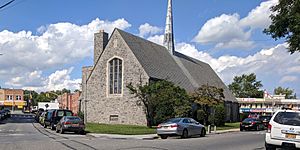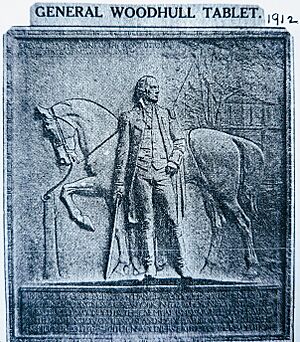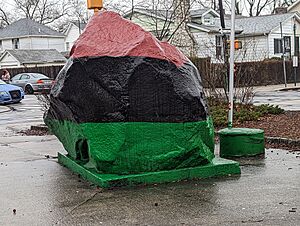Hollis, Queens facts for kids
Quick facts for kids
Hollis
|
|
|---|---|
|
Neighborhood
|
|

St. Gabriel's Hollis Episcopal Church
|
|
| Country | |
| State | |
| City | New York City |
| County/Borough | Queens |
| Community District | Queens 12 |
| Population
(2010)
|
|
| • Total | 20,269 |
| Ethnicity | |
| • Black | 64.0% |
| • Asian | 10.7% |
| • White | 2.3% |
| • Native American | 0.6% |
| • Hispanic | 13.2% |
| • Other/Multiracial | 9.1% |
| Time zone | UTC−5 (EST) |
| • Summer (DST) | UTC−4 (EDT) |
| ZIP Codes |
11412, 11423
|
| Area codes | 718, 347, 929, and 917 |
Hollis is a lively neighborhood in the southeastern part of Queens, one of New York City's five boroughs. It's mostly a place where many families live in single-family houses. While many residents are African-American, there are also people from Hispanic and South Asian backgrounds.
Hollis is located between the neighborhoods of Jamaica to the west and Queens Village to the east. Its main borders are 181st Street on the west, Hillside Avenue to the north, Francis Lewis Boulevard on the east, and Murdock Avenue to the south. The neighborhood uses ZIP Codes 11423 and 11412.
Contents
Hollis: A Look Back in Time
Early Days and the American Revolution
The first European settlers arrived in Hollis in the 1600s. They were Dutch families who built homes here. Later, during the American Revolutionary War, a part of the Battle of Long Island happened in this area. A brave general named Nathaniel Woodhull was captured at a local tavern. Today, Woodhull Avenue in Hollis is named after him.
For a long time, Hollis was mostly farmland. But in 1885, developers bought a large piece of land and built many houses. This is why Hollis still has so many single-family homes today. In 1898, Hollis became part of New York City.
A Changing Community
After the Korean War, many African-American families moved to Hollis. More recently, people from South Asia and the West Indies have also made Hollis their home. This mix of cultures makes Hollis a diverse and interesting place to live. Many parents in Hollis work, and there are several schools for young children.
Who Lives in Hollis?
Population and Diversity
According to the 2010 United States Census, about 20,269 people live in Hollis. The neighborhood is very diverse. Most residents are African American (64.0%). There are also significant numbers of Asian (10.7%) and Hispanic or Latino (13.2%) residents. Smaller groups include White, Native American, and Pacific Islander people.
Health and Income in the Community
The average life expectancy for people in Hollis and nearby Jamaica is about 80.5 years. This is very close to the average for all of New York City. The community has many young people and adults. About 22% of residents are under 18, and 27% are between 25 and 44 years old.
In 2017, the average household income in this area was around $61,670. About 20% of residents live in poverty, which is similar to the rest of Queens and New York City. About 12% of people are unemployed. Many families (56%) find it hard to pay their rent. Even with these challenges, Hollis is considered a stable neighborhood.
Learning and Libraries
Schools in Hollis
Hollis has several public schools run by the New York City Department of Education. These schools help students from kindergarten all the way through high school.
Here are some of the elementary schools:
- P.S. 35 Nathaniel Woodhull
- P.S. 118 Lorraine Hansberry
- P.S. 134 Hollis
For older students, Hollis also has:
- I.S. 192 The Linden (grades 6-8)
- P.S. 233 (grades K-1, 6, 9-12)
- Pathways College Preparatory School A College Board School (grades 6-12)
- Cambria Heights Academy (grades 9-12)
Local Libraries
The Queens Public Library has two branches in Hollis. These libraries offer books, computers, and programs for everyone in the community. You can find the Hollis branch at 202-05 Hillside Avenue and the South Hollis branch at 204-01 Hollis Avenue.
Getting Around Hollis
Train and Bus Services
Getting around Hollis and to other parts of New York City is easy. The Long Island Rail Road (LIRR) has a station right in Hollis, located at 193rd Street and Woodhull Avenue. This train mostly serves the Hempstead Branch.
Many local buses also serve Hollis, including the Q1, Q2, Q3, Q36, Q43, Q76, Q77, Q110 from MTA Regional Bus Operations. You can also catch the Nassau Inter-County Express (NICE) buses, like the n1, n6, n6X, n22, n24, n26, at Hillside Avenue and Francis Lewis Boulevard.
The New York City Subway's E, F <F> trains trains stop nearby at Jamaica-179th Street on Hillside Avenue. There were plans to extend the subway further into Hollis, but those plans were never finished.
Fun Parks and History
Liberty Triangle Park
Liberty Rock is a large boulder located in Liberty Triangle Park. This park is found where Farmers Boulevard and Liberty Avenue meet.
The Story of Liberty Rock
Liberty Rock is an important symbol for the African American community in Hollis and nearby areas. It's painted red, black, and green, which are the colors of the Pan-African flag. These colors represent civil rights, community identity, and connections among all people of African descent. The rock's location, where Hollis, St. Albans, and Jamaica meet, shows its importance to the whole community. It stands for strength and remembering cultural heritage.
The rock was first put up in the late 1940s or early 1950s as a memorial for soldiers who fought in World War II. In 1960, even President John F. Kennedy visited the rock during a campaign stop.
In the late 1960s, two young boys, Tony Tims and Daniel Gibson, decided to paint the rock. Tony got the idea from another small rock painted in the same colors. They painted it red, black, and green to represent the Black Power and Pan-African movements. This was a way for the community to show their pride and improve their neighborhood. At the time, the area around the rock was not well-kept. Residents worked together with local businesses to clean it up. Even though the city first didn't want the rock painted, the community fought for it and won. The original plaque honoring war veterans was moved to another spot.
Famous Faces from Hollis
Hollis has been home to many talented people, especially in the world of hip-hop and jazz.
Hip-Hop Legends
The neighborhood is famous for its connection to hip-hop. Russell Simmons, a very important hip-hop producer, grew up here. His brother, Joseph Simmons, along with Darryl McDaniels and Jason Mizell, formed the legendary rap group Run-D.M.C.. They even had a popular song called "Christmas in Hollis".
Other hip-hop artists from Hollis include:
- Black, Rock and Ron
- DJ Hurricane (born 1965)
- Ja Rule (born 1976)
- Irv Gotti (born 1970)
- LL Cool J (born 1968)
- Ed Lover (born 1963)
- Young MC
Jazz Musicians
By the 1950s, many famous African American jazz musicians also lived in Hollis. Some of them include:
- Jaki Byard (1922–1999), a jazz musician
- Roy Eldridge (1911–1989), a jazz trumpeter
- Roy Haynes (born 1925), a jazz drummer
- Milt Jackson (1923–1999), a jazz vibraphonist and drummer
- Phil Schaap (1951–2021), a jazz historian
Other Notable People
Hollis has also been home to people who made a difference in other fields:
- Augustus A. Beekman (1923-2001), a former New York City Fire Commissioner.
- Byron Brown (born 1958), the mayor of Buffalo, New York.
- Art Buchwald (1925–2007), a political humorist.
- Lord Burgess (1924–2019), a songwriter.
- Increase Carpenter (1737-1807), a Revolutionary War soldier and member of the Sons of Liberty.
- Gloster B. Current (1913–1997), a leader in the NAACP during the Civil Rights Movement.
- Lani Guinier (born 1950), a civil rights legal scholar.
- Brian Hardgroove, bass player for Public Enemy.
- Royal Ivey (born 1981), a basketball coach for the Brooklyn Nets.
- Daymond John (born 1969), founder and CEO of FUBU.
- Robert O. Lowery, the first African-American Fire Commissioner for the FDNY.
- Gregory Weldon Meeks (born 1953), a U.S. Representative.
- Lee Q. O'Denat, founder of World Star Hip Hop.
- Garrett Oliver (born 1962), a famous brewer and beer author.
- Diane Patrick (born 1951), a lawyer and former First Lady of Massachusetts.
- Rev. Al Sharpton (born 1954), a civil rights activist.
- Stephen A. Smith (born 1967), an ESPN sports personality.
- Andrew Young (born 1932), a civil rights activist and former U.S. Ambassador to the United Nations.



